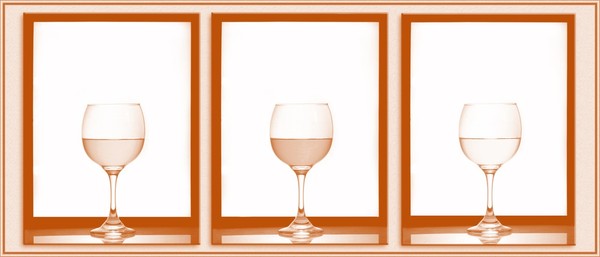.jpg)
“Let’s order the Sancerre… it’s complex and lasting”.
I don’t know what it was about this phrase but it became almost a catch-phrase for me: “Sancerre?” “Yes, it’s complex and lasting”. This was Bristol in the early 1990s: I shared a house on a hill in Totterdown (yes, it was steep). Back then at least, it wasn’t really the area for nice bars or restaurants. Amazingly, at the bottom of the hill, towards Temple Meads station and the city centre, was a little restaurant.
It went through several incarnations: first the Hard Ecu and then Glasnost, aiming to tap into the zeitgeist like nobody’s business. It had candles on the tables (probably in wine bottles), mismatched furniture, reasonably priced bistro-style food, and a very decent, one page wine list.
This certainly wasn’t my first wine… my brother and I grew up dipping our fingers into our parents’ pre-Sunday lunch glass of sherry, and of course I drank wine at university, but mainly at formal dinners, and with no great appreciation. The bar sold very cheap beer, and there was Oddbins round the corner if celebratory fizz was needed. Wine hadn’t always been a pleasant experience: when I was growing up Blue Nun and Leibfraumilch were a thing, and I’d definitely had some early experience of the right wine in the wrong place – tasting a young Bordeaux when without any food to temper the tannins, or finishing a glass of dry white after pudding. I didn’t understand what all the fuss was about.
So how did I come to fall in love with Sancerre? Sharing a bottle over dinner in Glasnost, I’d like to say I remember being stunned by the bone dry, racy acidity, the pronounced aromas and mouth-watering flavours of grapefruit, peaches and gooseberries, along with mineral, gunflint notes. And the body, the complexity and of course the length. But that’s what I’d say now. At the time, in the moment, it was simply “delicious”.
I can’t remember what I ate along with the Sancerre, but I guess that’s the beauty of it – it works superbly on its own but also complements and enhances things I loved then and still do: goat’s cheese, asparagus, seafood, herby things. Like Chablis, Sancerre is easy for English-speakers to pronounce, so much easier to order than a Bourgogne or Reuilly. It was also not the cheapest bottle on the menu, and ordering from further down the list seemed sophisticated for a recently graduated, recently earning 22-year-old. Unlike the wine, the relationship with my dining partner proved to be neither complex nor lasting.
Sancerre is a pretty hilltop town in the Central Vineyards of the Loire Valley, with a jumble of red-tiled roofs spilling down to the vine-clad slopes. It has been making wines since Roman times, but really made its name in in Parisian bistros and bars in the 1950s and 1960s. Sancerre's popularity soared worldwide in the 1970s and 1980s, thanks to its growing reputation as a high-quality, food-friendly wine.
Where does Sancerre’s complexity come from? I sometimes need to remind myself that it is, after all, 100% Sauvignon Blanc. I think there is a whole generation who associate Sauvignon Blanc with the “cat’s pee on a gooseberry bush” New Zealand style popular in the 1980s, similar to those wanting ABC (Anything But Chardonnay) because they tasted big, oaky, buttery Chardonnays in the 1990s. Sauvignon Blanc can be sublime, with flavours ranging from citrus to stone fruit to tropical fruit, and depending on the style, anything from herbaceous, mineral, spice or creamy notes. Grown in the cool continental climate of Sancerre, it retains plenty of refreshing acidity to balance its delicious fruit flavours.
There is certainly complexity in the terroir: the rolling hills have varied sloped vineyards with unique microclimates and distinctive soils. To the east of the town, towards the Loire, are the flinty silex soils that warm up and help the grapes ripen earlier, and impart stony, smoky aromas – especially the gunflint that I love. To the west and south-west are the ‘caillotes’, shallow gravel and limestone soils that produce the delicate, aromatic, earlier-drinking wines. Then there are the ‘terres blanches’: the famous Kimmeridgian chalk and marl limestone with fossilised seashells. The grapes ripen more slowly here, producing Sancerre with more density and structure that age beautifully.
In the winery, there are choices about fermentation temperature and vessels, and how to age the wine. I know now that the rich and creamy mouthfeel that I adore comes from maturing on the lees, as well as the texture from old oak. But it is the concentration of flavour of this wonderfully aromatic grape variety that shines through and gives that long and evolving finish.
The fact that I can remember “complex and lasting” and associate it with the taste of Sancerre is testament to the power of the tasting note. In this case, it was just a single line… to encapsulate everything in that bottle! A few carefully chosen words seeking to convey the essence of aromas, flavours, structure in black and white text – trying to distil the soul of the wine.
Some of the taste descriptors are a bit odd… I don’t want my wine to taste of petrol, forest floor or tinned green beans, but they all communicate a particular aroma perfectly. Smell is the sense that most strongly evokes memories, but these are of course personal to each of us. The art is to choose the right words to trigger an association, capture the imagination and compel you to taste the wine.
So thank you to the person that wrote the wine list tasting notes at Glasnost and introduced me to the wonderful experience of Sancerre, setting me on a journey of wine learning and discovery. A journey which is, indeed, complex and lasting!


.jpg)